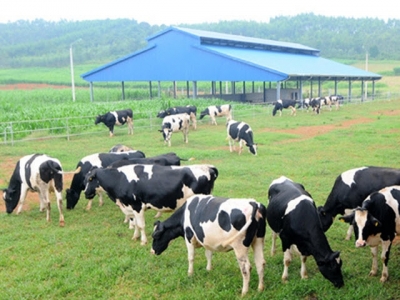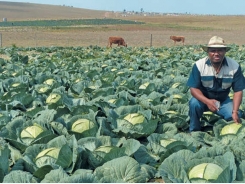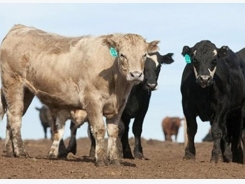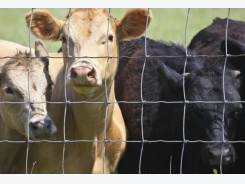Protein and Amino Acid Requirements for Close-Up Dry Cows

In the last 20 years, research has demonstrated how much dry cow nutrition can negatively affect cow health, milk production and reproduction. As a result, dry cow nutrition has evolved from management by neglect to diets that are tailored to prevent negative energy balance and the many metabolic problems that once plagued transition cows. Despite this transformation, there is still more that can be done to improve transition cow health and performance.
Metabolizable protein (MP) and amino acid supply are the new frontiers of close-up dry cow nutrition, says Robert Van Saun, extension veterinarian at Penn State University. Research to define the protein needs of transition cows is ongoing. But we now know that when formulating close up diets we must take into account the body protein that cows mobilize to support early lactation, the protein and amino acid needs of the growing fetus and the protein needed to maintain the cows’ labile protein reserve.
Fetal Growth Requirements
More than 70% of fetal growth occurs in the last 60 to 70 days of pregnancy. This places the greatest nutritional burden of pregnancy on the close-up dry cow just weeks before parturition when feed intake can be highly variable. Current feeding models for pregnant cows are based on end points of calf birth weight and fetal composition; and they do not address the potential loss of maternal body protein to support fetal requirements. Additionally, current requirements do not account for mammary gland growth and development.
The mobilization of body tissue doesn’t stop at parturition either. Research by van der Drift et al., 2012, showed that muscle mobilization occurred prepartum through four weeks postpartum for dry cows fed a diet containing 12.6% crude protein.
There is much interest and anecdotal evidence that suggest some benefit from feeding prepartum diets with an MP of 1,100 grams/day or more, explains Van Saun. This observed response may be due to an underestimation of the prepartum cows’ MP requirements, or from providing an essential amino acid or acids that the diet lacks, or because it allows for adequate MP intake for cows with lower feed intake, or some combination of these factors.
Amino Acids
Lower milk protein content may signal inadequate dietary MP supply and a repartitioning of amino acids to support immune response or glucose production in the liver. In reviewing lactation performance across many herds, I have found that cows with low milk true protein of 1,350 g/d, had improved reproductive performance.
All cows experience a period of negative protein balance in early lactation that seems somewhat independent of prepartum protein feeding. However, research by Ji and Dann, 2013, shows that when tissue protein mobilization does occur the reservoir of labile protein used in early lactation may be compromised resulting in greater risk for impaired health, productive efficiency, and reproductive performance.
Today protein must be defined as MP and amino acid requirements. These are the actual building blocks needed by the cow for tissue protein synthesis, gluconeogenesis, and other metabolic mediators. So far research has shown benefits from adding methionine, lysine and histidine to the diet. There also may be other essential and non-essential amino acids that can benefit the transition cow. Most amino acid research done so far has focused on milk production and milk composition response in early to mid-lactation.
Defining Dry Cow Protein Needs
Given our current understanding of transition cow nutrition, we should formulate close-up dry cow diets in two stages. The first stage is feeding the rumen to generate microbial mass, a significant source of MP. The second stage is feeding the cow over and above what nutrients are not provided by the rumen outflow. The same way lactating cow diets are formulated. In addition, the dry cows being fed must be better defined. Cow size, body condition score and the size of calf born must be considered to determine nutrient requirements. Expected birth weight can significantly influence nutritional requirements for the cow and must be accounted for. The biggest challenge will be in mixed groups of primiparous and multiparous cows. Obviously some animals may be overfed, but more importantly, we want to minimize the number of cows that may be underfed, stresses Van Saun.
Another challenge is deciding the appropriate intake level. When we formulate a diet for a group’s average intake, up to 50% of individuals in that group will consume less. Phillips et al., 2003, summarized prepartum intake data for multiparous Holstein cows. The average DMI was 27.1 +/- 5.5 lbs/day for the last 21 days before calving. They found that 15% of cows had a DMI of less than 22 lbs/day. Because of this underfeeding, the researchers recommended that close-up diets should contain 1,300 to 1,400 g/d of MP as a safety factor to ensure adequate numbers of cows consume the desired 1,080 g/d of MP from the diet.
Observational performance on farms suggests that protein content and protein source in the close-up dry cow diet is a critical factor to ensure cows transition smoothly. To further improve transition cow health and performance, we must better define dry cows to improve dietary formulation. Adjust dietary MP content to account for variability in feed intake. The goal should be for all close-up dry cows to consume a minimum of 1,000 g/d of MP. And I recommend feeding a close-up diet that contains 90-100 g of MP per kg of dry matter to meet the MP needs of a greater proportion of the dry cows in the group.
Choosing a Protein
Your decision on which protein product will best supply the metabolizable protein and essential amino acids your close-up dry cows need should be backed by research.
SoyPlus has been extensively researched at major universities throughout the USA. Incorporating SoyPlus in the diet allows use of lower total protein diets to reduce feed costs while maintaining or improving milk production and components.
Related news
Tools

Phối trộn thức ăn chăn nuôi

Pha dung dịch thủy canh

Định mức cho tôm ăn

Phối trộn phân bón NPK

Xác định tỷ lệ tôm sống

Chuyển đổi đơn vị phân bón

Xác định công suất sục khí

Chuyển đổi đơn vị tôm

Tính diện tích nhà kính

Tính thể tích ao




 5 Mistakes You Don't Want to Make When…
5 Mistakes You Don't Want to Make When…  Beef quality continuing to improve
Beef quality continuing to improve